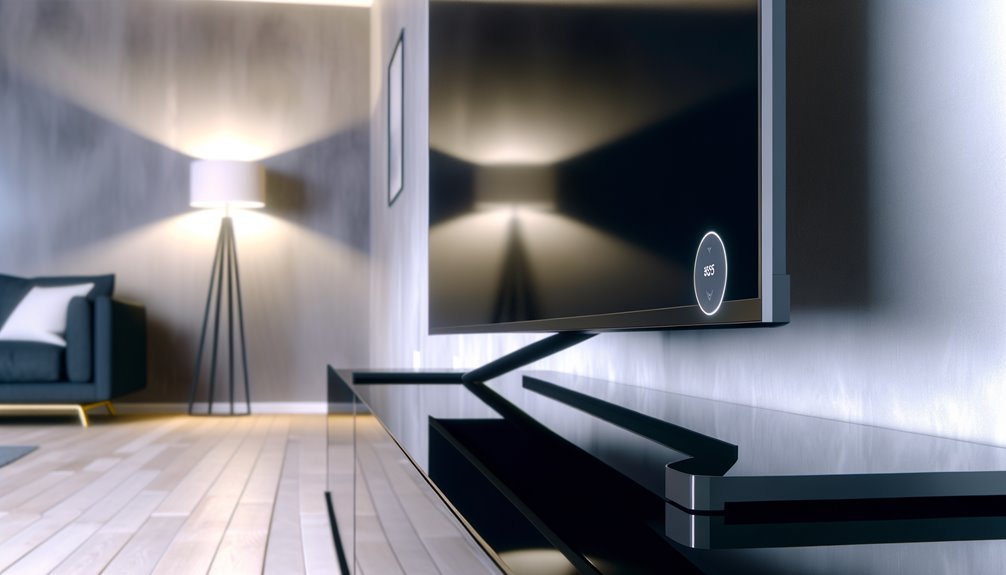To select the best TV aerial cable, you’ll want one with gold-plated connectors for peak conductivity and durability.
Look for OFC (oxygen-free copper) conductors, which reduce signal loss for clearer picture and sound. High-quality shielding minimizes electromagnetic interference, enhancing signal quality.
Consider top brands like SLX, Monoprice, and Philips, known for performance and reliability. Confirm the cable has a 75 Ohm impedance for compatibility, and select the right length to avoid slack and signal loss.
Proper installation and grounding enhance performance and longevity. For a deeper understanding of these features and maintenance tips, you’ll gain valuable insights.
Key Information
- Choose cables with gold-plated connectors for superior conductivity and corrosion resistance.
- Opt for OFC conductors to minimize signal loss for clearer picture and sound quality.
- Ensure the cable has high-quality shielding to protect against electromagnetic interference.
- Select cables with a 75 Ohm impedance for top-notch signal quality in TV aerial connections.
- Consider reputable brands like SLX, Philips, and Cable Matters for reliable performance and durability.
Key Features of TV Aerial Cables
When selecting a TV aerial cable, it’s important to take into account key features such as gold-plated connectors, OFC conductors, and high-quality shielding to guarantee efficient signal transfer and minimal interference.
Gold-plated connectors provide superior conductivity and resist corrosion, ensuring a consistent connection. OFC (Oxygen-Free Copper) conductors are essential as they minimize signal loss, providing a clearer picture and sound quality. High-quality shielding, typically made of multiple layers of foil and braid, protects against electromagnetic interference, maintaining signal integrity.
Additionally, consider cables with metal body plugs for enhanced durability and longevity. By focusing on these features, you’ll make sure your TV aerial cable delivers top performance and reliability, tailored to your specific installation needs.
Types of Coaxial Cables
Selecting the appropriate type of coaxial cable is essential for ensuring excellent signal quality and performance in your TV, FM, DAB, and satellite installations.
Low Loss CoAx cables, with a signal loss of around 2.7dB per 10m at 800MHz, are commonly used for TV and FM aerial connections.
Alloy Foil Type RG6 Satellite Cables, double screened, offer a lower loss of approximately 1.9dB per 10m at 800MHz, making them cost-effective.
Copper Foil Type Satellite Cables are also double screened and provide superior durability and longevity.
All downleads should have a 75 Ohm impedance for top-notch signal quality, crucial for minimizing 4G/5G interference.
Installers often choose RG6 coaxial cables for their balance of cost efficiency and effectiveness.
Top TV Aerial Cable Brands
Several top-tier brands dominate the market for TV aerial cables, offering products with features such as gold-plated connectors, low signal loss, and robust materials. SLX excels in signal boosters and amplifiers, guaranteeing clear reception.
Monoprice, praised for its affordability, offers easy-to-size cables. Philips provides durable construction and a lifetime warranty, addressing customer support needs effectively.
AmazonBasics delivers a variety of reliable coaxial cables suitable for multiple installations. Cable Matters is another strong contender, known for high-quality materials and excellent performance.
Choosing the Right Cable
To choose the right TV aerial cable, consider the cable’s shielding, which plays an essential role in minimizing signal loss and interference.
Additionally, you’ll want to make sure the cable length is just right—long enough to connect your aerial to your TV without unnecessary slack.
Impedance is also important; a standard 75 Ohm impedance is best for TV aerial connections.
Here’s a quick comparison to guide your selection:
| Feature | Importance |
|---|---|
| Shielding | Reduces signal loss and interference |
| Length | Prevents slack and signal degradation |
| Impedance | Ensures compatibility (75 Ohm) |
Don’t forget to look for reputable brands known for their quality and reliability. Finally, compare pricing to balance quality with affordability.
Installation and Maintenance Tips
Guaranteeing a seamless installation and maintaining your TV aerial cable efficiently requires attention to grounding, secure fastening, and proper routing.
Begin by properly grounding the cable to prevent signal interference and enhance safety.
Securely fasten the cable to avoid damage from external elements or accidental tugs.
Maintain a secure electrical connection to uphold excellent signal quality and prevent signal loss.
Follow the manufacturer’s instructions precisely for connecting the cable to the aerial and TV set.
Use cable clips or ties to neatly route and organize the cable, steering clear of sharp bends or kinks that could degrade signal strength.
Adhere to these steps to optimize your TV aerial cable’s performance and longevity.
Frequently Asked Questions
What Type of Aerial Cable Is Best?
You should consider RG-6 for satellite and cable TV due to its superior shielding. For analog TV, RG-59 works well. For long distances, go with RG-11. Fiber optic cables offer high bandwidth and minimal signal loss.
What Is the Best Cable to Run From an Antenna to a TV?
You should select a high-quality coaxial cable like RG-6 or RG-11 with gold-plated connectors and OFC conductors. Make sure the cable supports the required frequency range and has low attenuation for peak signal transmission and minimal interference.
Which Is Better RG6 or Rg11?
When choosing between RG6 and RG11, consider your installation needs. RG6 is cost-effective and suitable for most residential uses. However, for longer distances or high-frequency applications, RG11 provides superior performance despite its higher cost.
Does TV Aerial Cable Quality Matter?
Yes, TV aerial cable quality matters. You’ll get better signal transmission, reduced interference, and improved durability with high-quality cables. Investing in a good cable guarantees long-term performance and enhances your viewing experience.
Conclusion
When selecting the best TV aerial cable, consider key features like shielding, signal quality, and durability.
Familiarize yourself with the different types of coaxial cables to match your specific needs. Reputable brands guarantee reliability and performance.
Choose the right cable by evaluating your setup and requirements. Proper installation and regular maintenance will maximize your cable’s longevity and signal strength.
With these guidelines, you’ll secure a top-notch TV viewing experience while minimizing potential issues.



